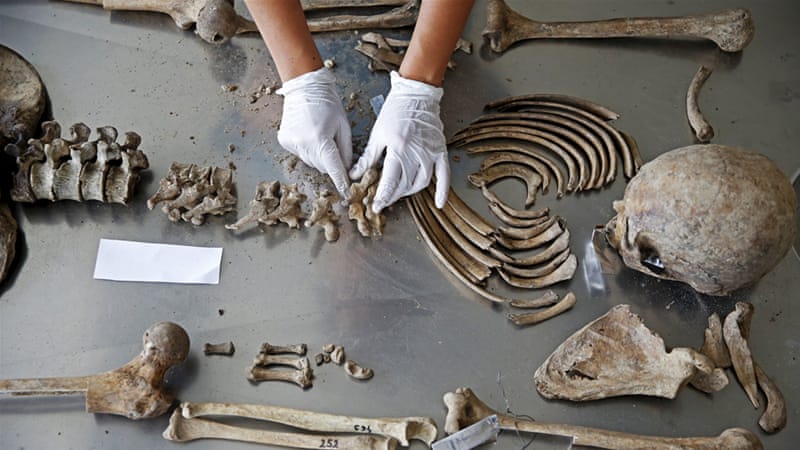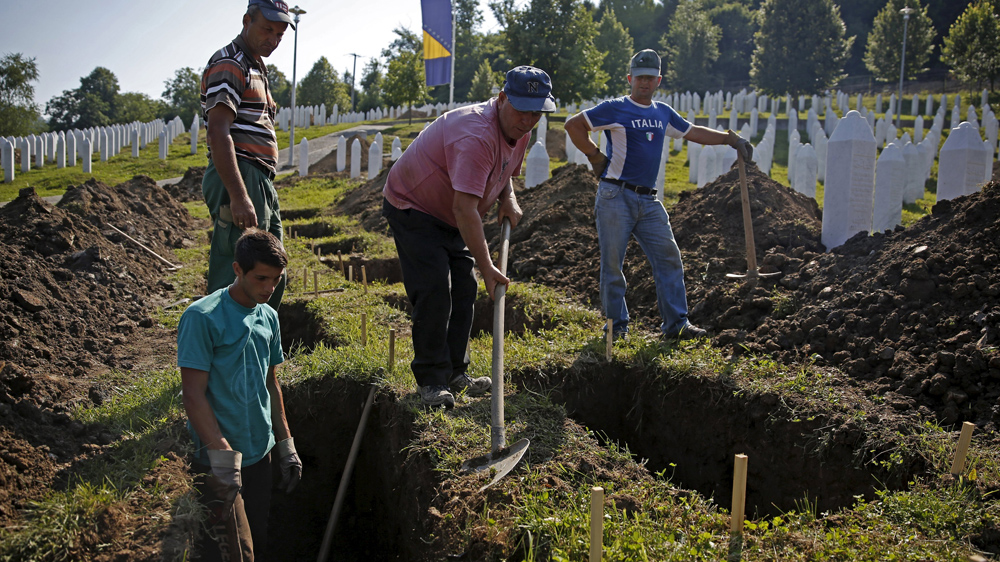
Srebrenica, Bosnia and Herzegovina – The violent breakup of Yugoslavia at the end of the Cold War left a painful legacy. It is estimated the conflict claimed over 100,000 lives, with thousands more missing, amid the chaos of ethnic cleansing and crimes against humanity.
Many are still struggling to deal with the pain and to find closure.
One small office, in a nondescript business park on the outskirts of the Bosnian industrial city of Tuzla, belongs to the International Commission on Missing Persons (ICMP).
Founded at the behest of then US president Bill Clinton at the G-7 summit in 1996, the ICMP was tasked with the almost impossible – to trace and identify the 40,000 people missing at end of the Yugoslav wars.
RELATED: Srebrenica genocide museum
A skull missing a mandible sits upright on a stainless steel mortuary slab. Scattered around it are fragments of bone shaped into the form of a skeleton. A few ribs, a fibula, two tibias, a handful of fingers. A poster poster on the wall pleads in Bosnian and English, “Help Identify Your Loved Ones. Give Your Blood Sample”.
Among the unaccounted were the more than 8,000 killed in the Bosnian town of Srebrenica in July 1995.
The massacre that took place at Srebrenica was the largest atrocity committed on European soil since the Second World War. Men and boys, overwhelmingly Bosnian Muslims, were shot in warehouses and bludgeoned to death on fields and football pitches.
 |
| A US soldier serving with the NATO-led peacekeeping force in Bosnia patrols while Bosnian forensic experts inspect bodily remains found in a mass grave in the eastern village of Kamenica, near the town of Zvornik [Danilo Krstanovic/Reuters] |
Bosnian Serb forces used bulldozers to push the bodies of their vicitms into unmarked mass graves. The bodies were subsequently exhumed, sometimes multiple times, to hinder identification.
The international community is still struggling to define the extent of the killings, 20 years later, and Russia vetoed the UN genocide resolution on Srebrenica on July 9.
Another method
Now these scattered human remains lie on the mortuary table of Dragana Vucetic, a tenacious Serbian forensic anthropologist at the ICMP Tuzla lab.
“When they removed those skeletal remains, often with big trucks, they destroyed the integrity of individuals. So very often we don’t find complete bodies,” Vucetic said.
Many bodies were so badly decomposed that the ICMP identified just 140 Srebrenica victims in its first five years, mainly through clothing and body parts.
“We had to find another method for investigation. So we made a DNA lab.”
Blood was collected from over 70,000 Bosnians, both in the Balkans and across Europe where they had fled as refugees.
Within months of the DNA lab opening in 2001, the ICMP had its first positive match. By the close of the following year, it had found more than 500 additional matches.
So far ICMP has identified nearly 7,000 people who died in Srebrenica.
Hasan Hasanovic was just 19 when Bosnian Serb forces led by the notorious general Ratko Mladic overran the Srebrenica enclave in July 1995, without the Dutch peacekeeping forces firing a shot.
Along with around 15,000 Bosnian Muslim men, Hasanovic fled to the hills, walking more than 100 kilometres to safety. Just 3,500 survived “the death march.” Hasanovic’s father and his twin brother did not make it.
His father’s body was identified in 2003, and interred among the rows and rows of brilliant white marble headstones at the graveyard for Srebrenica victims, located across the road from the former Dutch base at Potocari.
In 2005, Hasan Hasanovic buried his twin brother, too. “That was the hardest thing in my life,” he told Al Jazeera.
The process of identifying the Srebrenica victims is arduous. Bone samples from victims are taken for DNA testing and matched with profiles on the ICMP database. Courts require that DNA matches are of 99.95 percent probability or higher.
Once a body has been formally identified, the person is officially pronounced dead.
The ICMP facility is open to the public but relatives are discouraged from visiting to see the remains. “It is very emotional for them to see skeletons. Usually they expect that they will see something else. After 20 years, it is still stressful when they come here and see bones,” said Vucetic.
In 2010, the ICMP contacted Hatidza Mehmedovic. The remains of her husband and two sons – both killed at Srebrenica in July 1995 – had been identified.
“They told me my younger son was a complete body but I wasn’t brave enough to go and see him,” she told Al Jazeera.
Now Mehmedovic has just one wish – closure for all those who lost loved ones when Bosnian Serb forces took Srebrenica.
“All we want is justice so the criminals get punished and we find those that are still missing so mothers can at all least get the satisfaction of finding their sons. Many mothers have died – and will die – without being able to bury a single bone.”
 |
| Many women in Srebrenica are still awaiting to hear about the whereabouts of their loved ones who disappeared during the war [Damir Sagolj/Reuters] |
Almost 1,000 victims of the Srebrenica massacres are still missing and experts believe that at least one mass grave remains hidden in the verdant countryside in eastern Bosnia.
At the ICMP’s Tuzla facility, the remains of around 300 individuals await identification.
After identification, most will be interred during the annual July 11 commemorations at the Srebrenica victims’ graveyard. This year more than 100 people will be buried here.
Slow justice
In addition to identifying victims, the ICMP has played a key role in criminal prosecutions.
So far, 46 individuals have been put on trial at Bosnian state courts for their role in the Srebrenica massacre, including 38 people who have been charged with genocide.
The ICMP’s forensic evidence has been crucial in the 21 trials related to Srebrenica at the International Criminal Tribunal for the former Yugoslavia at The Hague, among them, the trial of Bosnian Serb leaders Radovan Karadzic and Ratko Mladic.
Despite these successes, justice has been “very slow” said Muhamed Durakovic, a Srebrenica survivor who now works for the ICMP in the Bosnian capital Sarajevo.
“There are hundreds of people roaming the streets of Srebrenica who are war criminals… Someone who took away your child is now working as a police officer or a public official in Srebrenica. To the victims that is totally unacceptable,” Durakovic said.
Meanwhile, a Srebrenica denial movement has sprung up. “Srebrenica hoax” is a popular search term on Google. Videos on YouTube promise the “real” story of what happened in July 1995, often using language and arguments familiar to Holocaust deniers.
Many of these denials emanate from Republika Srpska, an autonomous, majority-Serb region within Bosnia and Herzegovina. After the 1995 Dayton peace accords, which brought the conflict in Bosnia to an end, Srebrenica became part of Republika Srpska.
Recently Milorad Dodik, Republika Srpska’s president, called the Srebrenica massacre “the greatest deception of the 20th century”.
 |
| Workers dig graves at a memorial centre for Srebrenica Massacre victims in Potocari. Nearly 136 identified victims will be buried at a memorial cemetery during the ceremony, their bodies found in some 60 mass graves around the town [Dado Ruvic/Reuters] |
Arguments over Srebrenica are symptomatic of the divided nature of contemporary Bosnia. “The political, economic and social situation has gotten worse since the war,” said Srecko Latal, a Sarajevo-based analyst with the Balkan Investigative Reporting Network.
Bosnian politics is characterised by gridlock and stasis. Corruption is high, according to Transparency International. The official unemployment rate is over 40 percent.
The country’s patchwork of ethnicities are drifting further apart.
“You don’t have any ethnic mixing anymore in big towns. In schools a majority are mono-ethnic. Kids learn about other ethnic groups from the media and history books and they are all tainted,” said Latal.
The prospect of European Union membership, once held up as the goal that could unite post-war Bosnia and Herzegovina, looks increasingly remote. In recent years, much of the international community has pulled out of the country.
Meanwhile, the ICMP is one of the few genuine success stories to emerge from the impoverished, fissiparous post-war Western Balkans.
Their innovative DNA approach has been exported around the world, helping to identify victims of natural disasters and political violence everywhere from the United States and the Philippines to Chile and Iraq.
Next year, however, the ICMP is set to move its main operations to The Hague.
Bosnia and Herzegovina’s cash-strapped government is unlikely to step into the breach to fund expensive DNA laboratories.
In a grim irony, the future of the forensics lab at Tuzla could depend on discovering another Srebrenica mass grave, and soon.
This piece originally appeared on Al Jazeera.